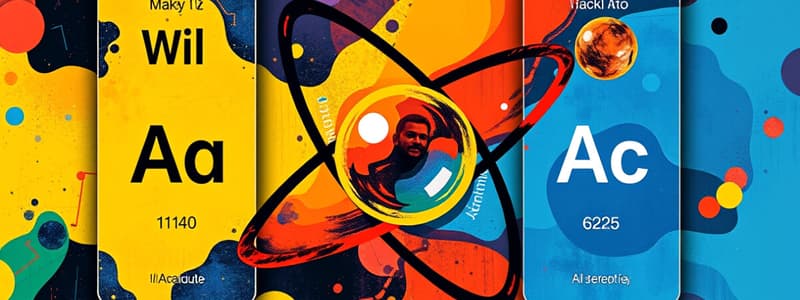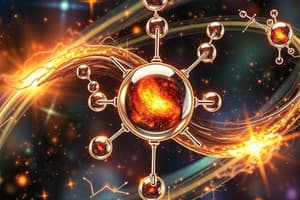Podcast
Questions and Answers
What is an atom?
What is an atom?
- The number of protons in an atom
- The smallest unit of matter (correct)
- A substance that cannot be broken down
- Negatively charged particles
What is an element?
What is an element?
A substance that cannot be broken down into simpler substances by ordinary chemical means
How is an element represented?
How is an element represented?
A symbol that consists of either 1 or 2 letters (the first is always capitalized; if there's a second, it's always lowercase)
What is atomic mass?
What is atomic mass?
What is atomic number?
What is atomic number?
What is a proton?
What is a proton?
What is a neutron?
What is a neutron?
What is an electron?
What is an electron?
What is the nucleus?
What is the nucleus?
What are valence electrons?
What are valence electrons?
What is the valence shell?
What is the valence shell?
What is reactivity?
What is reactivity?
What is the magic number?
What is the magic number?
Why do atoms (except hydrogen and helium) want 8 electrons in their valence shell?
Why do atoms (except hydrogen and helium) want 8 electrons in their valence shell?
What is a noble gas?
What is a noble gas?
What is a periodic table?
What is a periodic table?
What is a group/family in the periodic table?
What is a group/family in the periodic table?
What is a period in the periodic table?
What is a period in the periodic table?
What is an isotope?
What is an isotope?
What is an ion?
What is an ion?
What is an ionic bond?
What is an ionic bond?
What is a covalent bond?
What is a covalent bond?
What is a metal?
What is a metal?
What is a nonmetal?
What is a nonmetal?
What is conductivity?
What is conductivity?
What is a compound?
What is a compound?
What type of compound has high conductivity?
What type of compound has high conductivity?
What type of compound has low conductivity?
What type of compound has low conductivity?
What is a Lewis dot diagram?
What is a Lewis dot diagram?
What is the law of conservation of mass?
What is the law of conservation of mass?
What is a chemical formula?
What is a chemical formula?
What is a chemical equation?
What is a chemical equation?
What are reactants?
What are reactants?
What are products?
What are products?
What is a physical change?
What is a physical change?
What are examples of physical changes?
What are examples of physical changes?
What is a chemical change?
What is a chemical change?
What are examples of chemical changes?
What are examples of chemical changes?
What are ways to speed up a chemical reaction?
What are ways to speed up a chemical reaction?
What are ways to tell if a chemical reaction has occurred?
What are ways to tell if a chemical reaction has occurred?
What is a catalyst?
What is a catalyst?
What is a precipitate?
What is a precipitate?
What is an endothermic reaction?
What is an endothermic reaction?
What is an exothermic reaction?
What is an exothermic reaction?
What is a physical property?
What is a physical property?
What is luster?
What is luster?
What is malleability?
What is malleability?
What is a chemical property?
What is a chemical property?
What is pH?
What is pH?
What is a characteristic property?
What is a characteristic property?
What is density?
What is density?
What is the formula for density?
What is the formula for density?
What is a mixture?
What is a mixture?
What is a heterogeneous mixture?
What is a heterogeneous mixture?
What is a homogeneous mixture?
What is a homogeneous mixture?
What type of change takes place when a compound is formed?
What type of change takes place when a compound is formed?
What type of change takes place when a mixture is formed?
What type of change takes place when a mixture is formed?
What is filtering?
What is filtering?
What is sifting?
What is sifting?
What is evaporation?
What is evaporation?
What is a solution?
What is a solution?
Flashcards are hidden until you start studying
Study Notes
Fundamental Concepts of Chemistry
- Atom: The smallest unit of matter, fundamental building block of all substances.
- Element: A pure substance that cannot be decomposed into simpler substances through ordinary chemical reactions.
- Chemical Symbol: Represents an element, consisting of one or two letters; the first letter is capitalized, while any second letter is lowercase.
Atomic Structure
- Atomic Mass: The combined number of protons and neutrons within an atom.
- Atomic Number: Represents the number of protons in an atom's nucleus, unique for each element.
- Protons: Positively charged particles found in an atom's nucleus.
- Neutrons: Neutral particles that contribute to the mass of an atom, located in the nucleus.
- Electrons: Negatively charged particles that orbit the nucleus of an atom.
Chemical Bonding
- Valence Electrons: Electrons in the outermost energy level of an atom involved in forming bonds.
- Valence Shell: The outermost energy level of an atom where valence electrons reside.
- Reactivity: Indicates an atom's tendency to bond with others; influenced by its valence electrons.
- Magic Number: Generally refers to an atom's desire for 8 electrons in its valence shell (except hydrogen and helium) for stability.
Periodic Table
- Noble Gas: Stable elements that do not readily form bonds due to full valence shells.
- Periodic Table: A systematic arrangement of elements by increasing atomic number and atomic mass.
- Groups/Families: Vertical columns in the periodic table indicating elements with similar properties.
- Periods: Horizontal rows in the periodic table representing elements with increasing atomic number.
Isotopes and Ions
- Isotope: Variants of a single element that differ in neutron number, resulting in different atomic masses.
- Ion: An atom or molecule that carries a charge due to the loss or gain of one or more electrons.
Types of Chemical Bonds
- Ionic Bond: Forms between metals and nonmetals where valence electrons are transferred.
- Covalent Bond: Occurs between nonmetals where valence electrons are shared.
Substances and Properties
- Conductivity: The ability of a substance to conduct electricity, often high in ionic compounds.
- Compound: A substance resulting from the chemical combination of two or more elements.
- Ionic Compound: Typically has high conductivity due to free-moving ions.
- Covalent Compound: Generally exhibits low conductivity because electrons are shared.
Chemical Change and Reactions
- Law of Conservation of Mass: States that mass is neither created nor destroyed during a chemical reaction.
- Reactants: Substances present before a chemical reaction occurs.
- Products: Substances formed as a result of a chemical reaction.
- Chemical Change: Alters the atomic structure of a substance; includes processes like combustion and rusting.
Physical and Chemical Properties
- Physical Change: A change where the atomic structure remains unchanged (e.g., melting ice).
- Chemical Property: A characteristic that becomes evident during a chemical reaction.
- Luster: Describes the shine of a substance.
- Malleability: The ability of a substance to deform without breaking.
Mixtures and Separation Techniques
- Mixture: A physical combination of two or more substances; can be homogeneous or heterogeneous.
- Heterogeneous Mixture: Individual components are distinguishable (e.g., salad).
- Homogeneous Mixture: Components are uniformly distributed, appearing as a single phase (e.g., saltwater).
- Separation Methods: Include filtering (removal of solids from liquids), sifting (separating different-sized solids), and evaporation (separating solids from homogeneous mixtures).
Reaction Rates and Indicators
- Factors to Speed Up Chemical Reactions: Increase concentration, surface area, temperature, or add a catalyst.
- Chemical Reaction Indicators: Observable signs such as bubble formation, temperature changes, precipitate formation, or color changes.
Thermodynamics in Reactions
- Endothermic Reaction: Absorbs heat, lowering surrounding temperature.
- Exothermic Reaction: Releases heat, raising surrounding temperature.
Fundamental Measurements
- Density: The ratio of mass to volume, provides insight into how substances will interact.
- pH: Gauge of whether a substance is acidic or basic.
- Characteristic Property: A property that remains constant despite sample size variations.
Studying That Suits You
Use AI to generate personalized quizzes and flashcards to suit your learning preferences.




